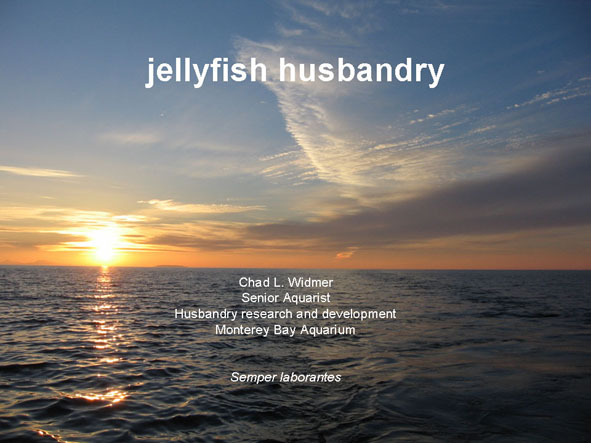Rearing
polyps and medusae in aquaria
Chad Widmer

Fig. 1 - Introductory slide
Fig. 2 - When collecting wild jellies look in the edges of the slicks ....
Fig. 3 - To collect jellies in Monterey Bay I use a 19 feet long Boston Whaler, a plankton net and a long handled dip net ...
Fig. 4 - When you return to the lab ...
Fig. 5 - Remove the hyperiid amphipods ...
Fig. 6 - I frequently find juvenile slender crabs riding around on the jellies ...
Fig. 7 - Starting new cultures of jellies ...
Fig. 8 - I spawned these jellies on a ship in the Sea of Cortez ...
Fig. 9 - For fertilization in vitro, simply remove bits of mature gonad ...
Fig. 10 - Development ...
Fig. 11 - I like to arrange my scyphistomae dishes so that the polyps hang ...
Fig. 12 - Enriched Artemia nauplli and rotifers are good foods ...
Fig. 13 - Watch out for contamination ...
Fig. 14 - Aquaria for ephyrae ...
Fig. 15 - Aquaria for medusae ...
Fig. 16 - Some jellies are easier to grow than others ...
Fig. 17 - General rules of thumb ...
Fig. 18 - Acknowledgements ...
About the Author
Chad L. Widmer has managed display, culture and acquisition of
the permanent jellyfish galleries at the Monterey Bay Aquarium, on Cannery
Row in Monterey, California for over six years. He is an active jellyfish
researcher and contributes regularly to peer-reviewed scientific journals.
His research focuses primarily on jellyfish life cycles with an eye
toward better understanding jellyfish bloom ecology. He is currently
writing a basic manual on jellyfish husbandry that will detail all aspects
of jelly keeping. The book should be available in late 2008. He enjoys
few things more than setting off car alarms when he rides his Harley
Davidson motorcycle.